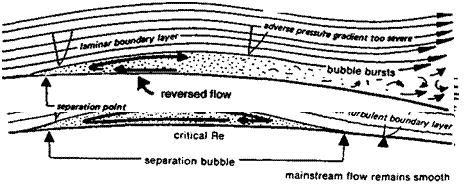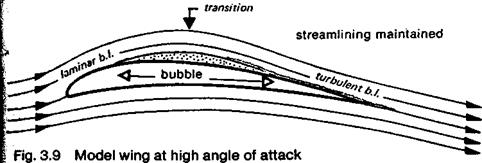LAMINAR SEPARATION
 |
In Figure 3.5 it is supposed that a model wing has a laminar boundary layer at the leading edge, with fairly high angle of attack. Over the front portion of the wing the pressure decreases as the airflow accelerates. The upper laminae thus feel slightly more viscous traction from above. They speed up, and pass this acceleration down from layer to layer so that the whole boundary layer gains momentum. The increasing velocity helps to
I Fig. 3.8 Typical small model wing at low angle of attack
Laminar separation with long bubble and turbulent re-attachment
|
|
Short bubble with turbulent re-attachment

maintain laminar flow, quite large bumps and imperfections in the wing may be overbidden without transition.
Where the point of minimum pressure is reached, the mainstream flow begins to slow blown. This checks the outermost lamina of the boundary layer and it, too, begins to slow. down. The influence passes downwards as before. However, the lower laminae were ‘ never moving very fast, and it requires only a slight deceleration for them to be brought to standstill. Some distance behind the minimum pressure point, therefore, the lowest parts of the laminar boundary layer halt The air at this point is stagnant and it forms a barrier ito the air moving in from upstream. The longer the deceleration continues, the more the boundary layer slows down. The stagnant barrier grows in size, forcing the flow off the wing surface altogether. This is laminar separation.












